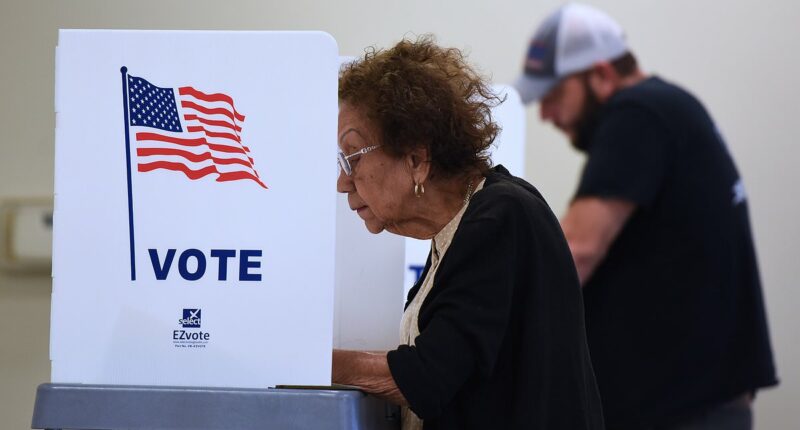Share this @internewscast.com
A new analysis of Americans’ voter registration habits points to potential long-term trouble for the Democratic Party.
Research conducted by the New York Times has shown a decrease in the number of registered Democrats in every state that records voter affiliations by party, encompassing 30 out of the 50 states in the U.S.
The remaining 20 states do not register voters by party.
This trend was consistent between swing states, red states, and blue states.
The New York Times notes that explicitly, ‘fewer and fewer Americans are choosing to be Democrats.’
The Times attributes Trump’s sweeping 2024 victory—including wins in every swing state and the national popular vote—to this very trend.
For veteran political activists and observers, this shift comes as no surprise.
In latest voting cycles, states transitioning from Democrat to GOP typically experience Republican voter registration increases prior to election outcomes.

People fill out vote-by-mail ballots at the Orange County Supervisor of Elections office on October 17, 2024 in Orlando, Florida

Republican presidential nominee, former U.S. President Donald Trump, participates in a roundtable discussion at the Latino Summit held at Trump National Doral Golf Club on October 22, 2024, in Doral, Florida.
Florida, historically a key swing state—from the notable 2000 Bush-Gore recount to the close Trump-Clinton race in 2016—has strongly leaned Republican over the last ten years.
Republican gains with Hispanic and Latino voters have been pointed to as one reason for the shift.
A significant event occurred in March, as Republican registrations overtook Democrats in Miami-Dade County, a former Democratic base and Florida’s largest county. Currently, Republicans account for 34 percent of registered voters there, surpassing Democrats (32 percent) and Independents (33 percent).
These trends in voter registration and party loyalty suggest that political realignments in key states may be more durable than previously thought.
Evan Power, chair of the Republican Party of Florida, stated to the Florida Phoenix that the change was ‘a complete rejection of the Democrats’ unsuccessful agenda. Miami-Dade is no longer a Democrat stronghold — it’s now the epicenter of the Republican movement.’

Evan Power, Chair of the Republican Party of Florida since January 2024
Iowa is another state where Republicans have recently made major gains. After the 2018 midterm cycle, three of the state’s four congressional seats were held by Democrats.
Republicans subsequently made voter registration a top priority in the 2020 presidential election, and made gains not only in swing seats but statewide before Trump’s second victory in the state.
After the 2020 election, Republicans held three of the four congressional seats in the state and flipped the fourth into their column after the 2022 midterm election.
Conservative activist Scott Presler is the Founder and Executive Director of Early Vote Action and has travelled across the country registering voters in swing states and districts for the past half-decade. Presler told the Daily Mail that he often gets asked if registering more GOP voters in a location means an automatic win.
He points to his efforts in flipping Bucks County, Pennsylvania for Trump last year as one indication that the proof is in the pudding.

Scott Presler registering voter in the Commonwealth of Pennsylvania
The county is one specifically mentioned in the New York Times analysis, as Republicans flipped the voter registration there last summer in part due to Presler’s activism ahead of Trump’s win in November.
The Daily Mail spoke to Presler via a phone call while he was back in Pennsylvania, this time as part of an effort to flip the swingiest of all swing counties, Erie County, which is ‘5,900 voters away from flipping blue to red.’
Presler said that recent conversations with individuals he’s gotten to change their party registration indicate that the data analyzed by the New York Times is ’emblematic of the fact that voters overwhelmingly approve of Trump’s policies.’
While both parties have had their fair share of infighting, Democrats seem to be losing the most in the eyes of voters. After Trump’s decisive defeat of Kamala Harris last year, the party is searching for a new leader.
The likes of California Governor Gavin Newsom and Connecticut Senator Chris Murphy are putting themselves forward as figureheads of the anti-Trump resistance, but looking at registration numbers, no one has yet broken through to the average voter to get them to switch back into the Democratic column.
Democrat strategist and DNC member Maria Cardona told the New York Times that her party ‘fell asleep at the switch’ also adding that young Hispanic and Latino voters are no longer default supporters of her party.

















